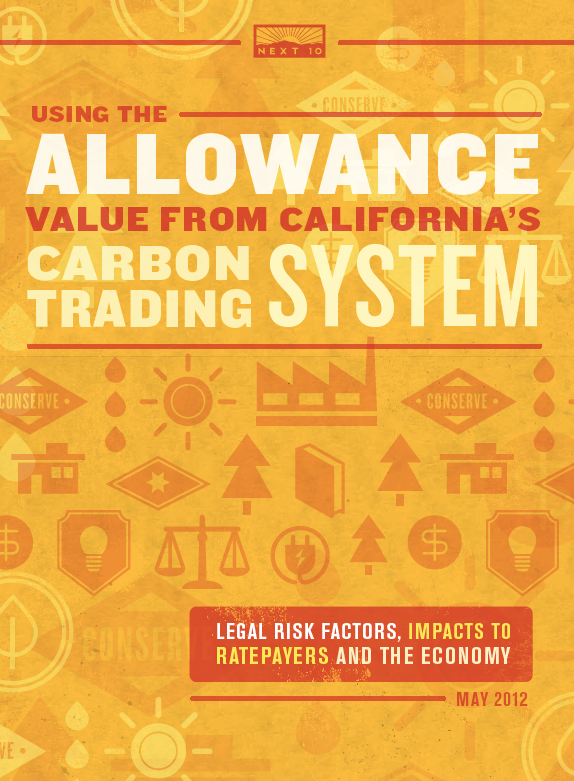Publications
Using the Allowance Value from California’s Carbon Trading System: Legal Risk Factors, Impacts to Ratepayers and the Economy
New Next 10 report seeks to better understand California’s cap-and-trade program and different alternatives for how the state can use the allowance value created under the cap-and-trade program. The findings in this report summarize a series of reports commissioned by Next 10 that represent the first extensive analysis on the issue of alternative uses of allocation value and the revenue derived from permit auctions.
The four studies together provide legal and economic analysis of different investment scenarios, including impacts on utility ratepayers and the economy:
- Options for Cap and Trade Auction Revenue Allocation: An Economic Assessment for California by David Roland-Holst
- California’s Cap-and-Trade Auction Proceeds: Taxes, Fees, or Something Else? by Dan Farber and Deborah Lambe
- For the Benefit of California Electricity Ratepayers: Electricity sector options for the use of allowance value created under California’s cap-and-trade program by Dallas Burtraw and Sarah Jo Szambelan
- A Primer on the Use of Allowance Value Created under the CO2 Cap-and-Trade Program also by Dallas Burtraw and Sarah Jo Szambelan
Options for Cap and Trade Auction Revenue Allocation: An Economic Assessment for California is the first macroeconomic study to examine the economic impact of spending revenues generated by the sale of cap and trade emissions allowances. Key findings include:
- Models the Gross State Product (GSP), jobs, and state revenue impact of 18 different possible spending options for cap and trade revenues to be distributed to the state’s Air Pollution Control Fund
- Most of the spending options modeled create a greater return than the initial investment
- Energy efficiency projects offer the biggest boost in terms of jobs, GSP, and state revenue
- The chart below includes the macroeconomic impacts in 2020 from $100 million annual investments (from 2013) on five of the 18 alternatives modeled in the report:
| Auction Revenue Spending Options | Real GSP (2010 $USD) | State Revenue (millions) | Employment (full-time) |
|---|---|---|---|
| Energy efficiency actions to upgrade residential lighting | $997 | $58 | 6,902 |
| Offset General Fund expenditures through creative financing approaches | $285 | $26 | 1,710 |
| Small business energy efficiency | $468 | $10 | 6,480 |
| Financing program for renewable energy installations at residential properties | $664 | $57 | 6,765 |
| Bookends of the High Speed Rail project | $442 | $31 | 2,651 |
California’s Cap-and-Trade Auction Proceeds: Taxes, Fees, or Something Else? offers a legal analysis of different strategies for spending revenues raised through the sale of emissions allowances in California. Key findings include:
- The same energy efficiency programs projected to give the economy the biggest boost in the study Options for Cap and Trade Auction Revenue Allocation: An Economic Assessment for California are also considered relatively "low-risk" on the legal front.
- The proposed funding of the bookends of the High Speed Rail (*note not the entire project) was found to be a relatively low- to medium-legal-risk spending option.
- Spending revenues on items that do not support the goals of AB 32, to mitigate greenhouse gas emissions, is considered legally risky. So, any future possible plans to return the proceeds to close future budget gaps are both considered "high-risk" options.
For the Benefit of California Electricity Ratepayers: Electricity sector options for the use of allowance value created under California’s cap-and-trade program examines how California ratepayer utility bills will be impacted by the cap-and-trade program. Key findings include:
- Measures the impact of three scenarios on electricity costs and finds that allowance value created by the sale of IOU allowances can offset all or nearly all of the increased costs to ratepayers.
- The chart below details the net change in costs for California households receiving basic-level utility service in the summer months (before accounting for the possible benefits of investments under the various proposals):
| Utility | Proposal #1 - Cost Impacts | Proposal #2 - Cost Impacts | Proposal #3 - Cost Impacts |
|---|---|---|---|
| PG&E | 0.0% | 0.3% | 1.4% |
| SCE | -0.1% | 0.4% | 2.3% |
| SDG&E | 0.0% | 0.3% | 1.2% |
A Primer on the Use of Allowance Value Created under the CO2 Cap-and-Trade Program examines key aspects of the cap-and-trade program including what allowance value is, who will make the decisions about this billion dollar plus revenue source, the timeline for major decisions, and how different Californians might be impacted.
